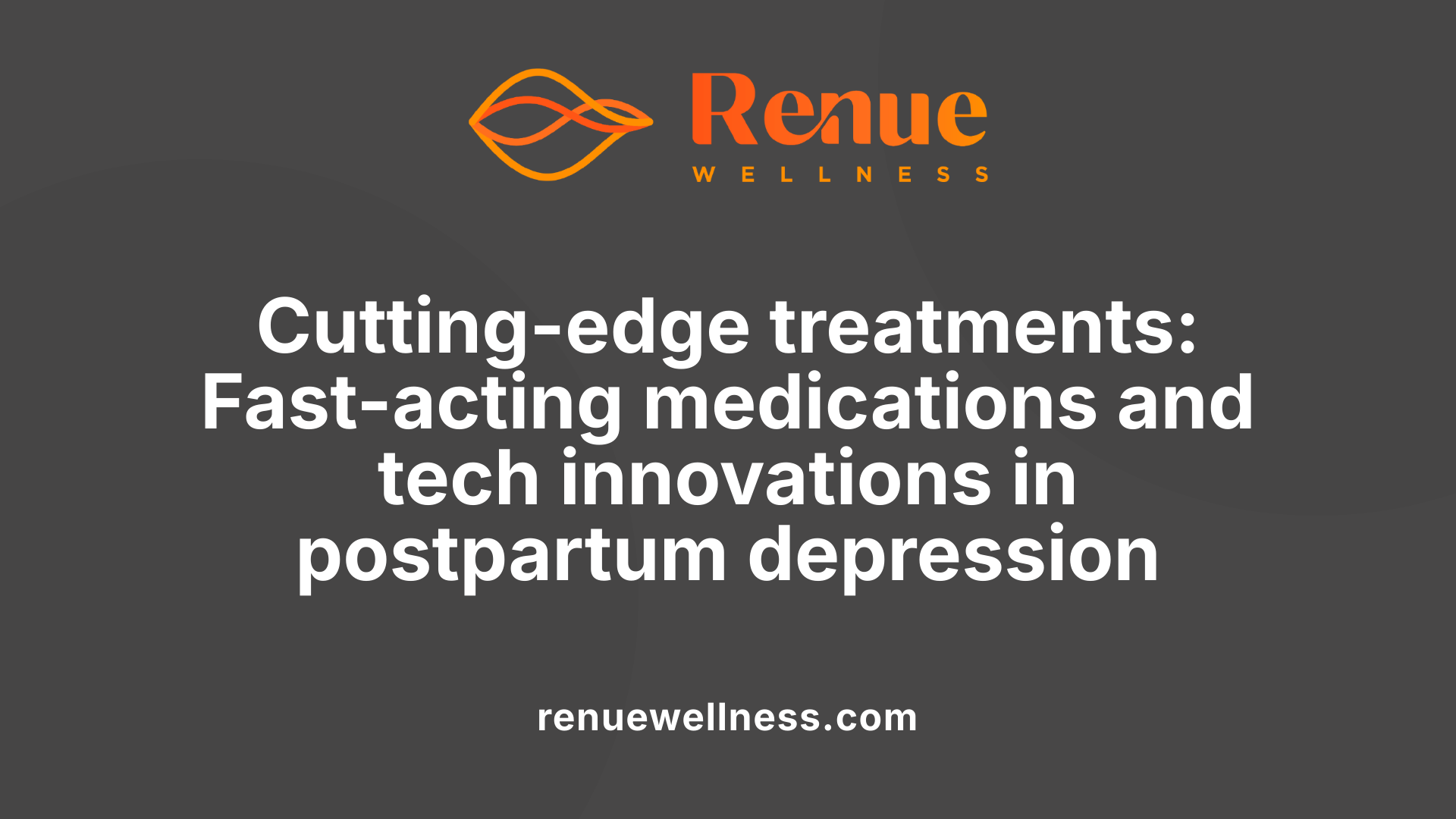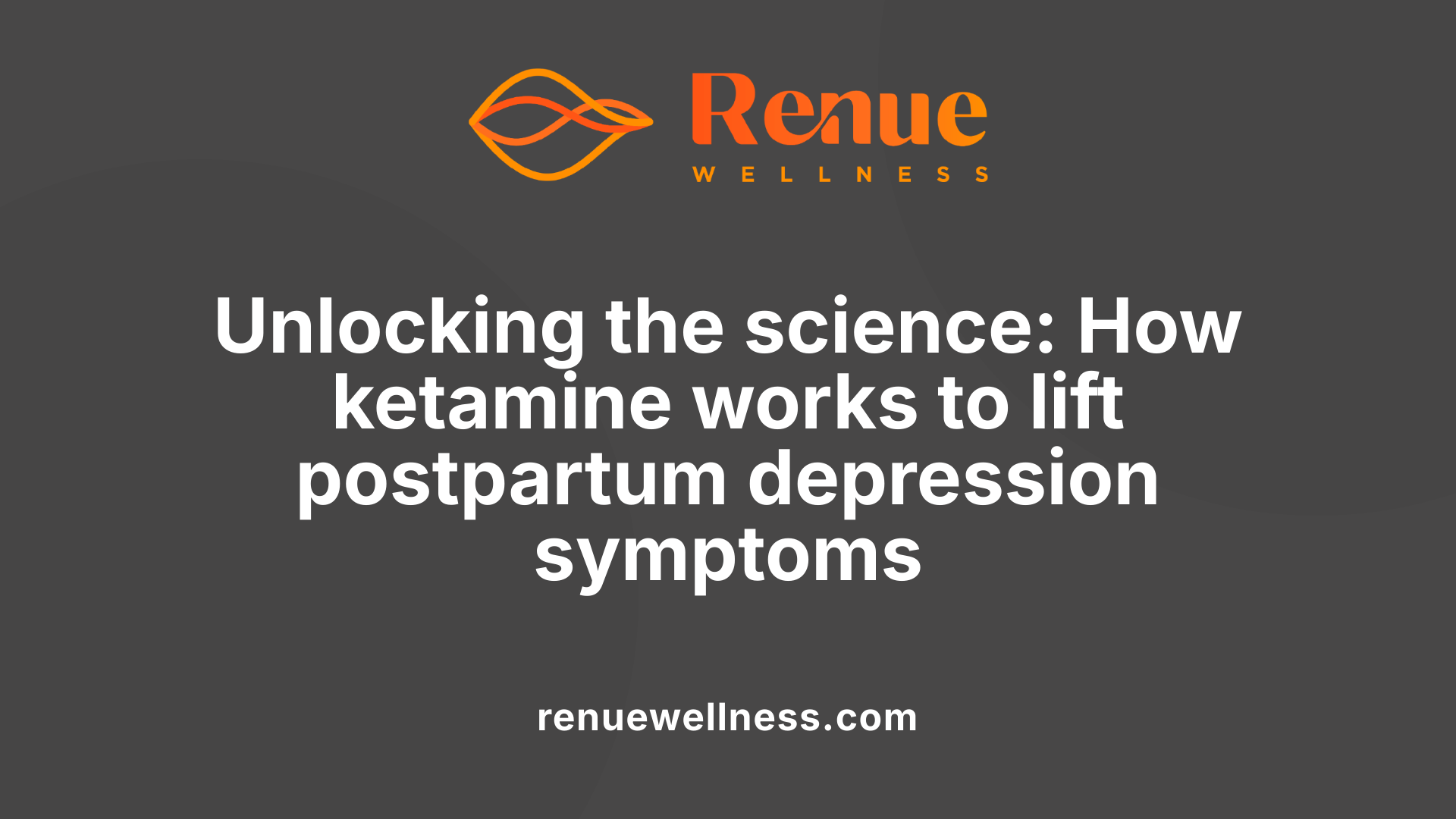Postpartum Depression and Ketamine: What New Mothers Should Know


August 1, 2025
Understanding Postpartum Depression and the Promise of New Treatments
Postpartum depression (PPD) is a significant mental health concern affecting up to 15% of new mothers worldwide. Characterized by persistent sadness, anxiety, fatigue, and difficulty bonding with the newborn, PPD can have lasting impacts on both mother and child. Traditional treatments, including psychotherapy and antidepressants, often require weeks to take effect, leaving many women vulnerable during the critical postpartum period. Recent advances in medical research highlight the potential of ketamine and esketamine as fast-acting alternatives, offering hope for rapid symptom relief and improved long-term outcomes.
Traditional and Emerging Treatments for Postpartum Depression

What are the traditional treatments for postpartum depression?
Postpartum depression (PPD) is a serious condition affecting approximately 10% to 15% of new mothers. Traditional treatment strategies have long centered around psychotherapy and medication, often tailored to each woman’s preferences and clinical needs.
Psychotherapy, particularly cognitive-behavioral therapy (CBT) and interpersonal therapy (IPT), has proven effective in helping women manage symptoms of PPD. These approaches focus on modifying negative thought patterns and improving personal relationships, providing a solid foundation for recovery. Many women respond well to such therapy, especially when started early.
On the pharmacological front, antidepressants like selective serotonin reuptake inhibitors (SSRIs) are commonly prescribed. Drugs such as sertraline, paroxetine, and nortriptyline are frequently used and generally considered safe during breastfeeding when properly monitored by healthcare providers. Despite their effectiveness, these medications usually take about 4 to 8 weeks to produce noticeable improvements, which can be challenging for women needing rapid relief.
Emerging hormonal therapies are gaining attention as potential treatments for PPD. Brexanolone, a neuroactive steroid, has received FDA approval for postpartum depression and offers a targeted approach by modulating GABA receptors. Zuranolone is another promising neuroactive steroid under clinical investigation. While effective, these treatments are not yet universally available and are typically administered under specialized medical supervision.
In addition to psychological and pharmacological strategies, lifestyle modifications can play a supportive role. Interventions such as light therapy, omega-3 fatty acid supplementation, acupuncture, massage, and increased physical activity have demonstrated potential benefits with minimal risks. Support groups and peer counseling also provide emotional support, reducing feelings of isolation and fostering resilience.
Integrating these approaches into a comprehensive care plan allows healthcare providers to individualize treatment, ensuring that each mother’s unique circumstances and preferences are addressed. In this way, a combination of psychological, pharmacological, hormonal, and lifestyle strategies forms the backbone of traditional postpartum depression management—a foundation that continues to evolve with new research and therapies.
Innovations in Treating Postpartum Depression: The New Wave

What are emerging and innovative treatments for postpartum depression?
Recent developments in postpartum depression (PPD) treatment are shifting towards faster-acting and more targeted options. FDA-approved medications like brexanolone and zuranolone have paved the way for biological therapies that offer quicker symptom relief compared to traditional antidepressants.
Brexanolone, introduced in 2019, is administered via intravenous infusion and works by mimicking the neurosteroid allopregnanolone, which fluctuates after childbirth. Its rapid action can significantly reduce depressive symptoms within days, offering hope for new mothers who need immediate support.
In 2024, zuranolone (marketed as Zurzuvae) became the first oral neurosteroid modulator approved for PPD. It acts by modulating GABA receptors, enabling effective symptom relief in just a few days. This oral form allows for easier administration and increased accessibility.
Beyond medications, non-pharmacological therapies are gaining traction. Transcranial magnetic stimulation (TMS) uses magnetic fields to stimulate neural activity in specific parts of the brain associated with mood regulation. Early studies suggest that TMS is safe and may provide another option for women who do not respond to medications.
Innovations in psychotherapy, including digital therapy platforms and telehealth, have expanded access to mental health care. These tools enable women to receive counseling remotely, reducing barriers related to stigma or logistics.
Researchers are also investigating the long-term safety of these novel treatments to ensure they are effective and safe for both mothers and infants, especially for those who are breastfeeding.
The convergence of pharmacological breakthroughs and technological advancements marks a significant shift towards biologically targeted and rapidly effective treatments for postpartum depression. These innovations are transforming the landscape of maternal mental health care, offering faster relief and broader options for women worldwide.
The Role of Ketamine and Esketamine in Managing Postpartum Anxiety and Depression

What is the role of ketamine and esketamine in treating postpartum depression?
Ketamine and esketamine are gaining recognition as innovative options for managing postpartum depression (PPD). Unlike traditional antidepressants, which may take weeks to show benefits, ketamine-based treatments offer rapid symptom relief, often within hours or days.
Recent clinical research, including randomized controlled trials and comprehensive meta-analyses, underscores their potential. For example, studies show that administering a low dose of ketamine immediately after childbirth during cesarean sections can significantly cut down the chances of developing depression within the first few weeks postpartum. Similarly, a 2024 study involving over 4,300 women found that both ketamine and esketamine considerably lowered the incidence of postpartum depression, with esketamine reducing the risk of major depressive episodes by approximately 75% in women with prenatal depression.
These drugs operate by targeting the brain’s glutamate system via NMDA receptor antagonism, which differs from the mechanism of traditional antidepressants like SSRIs. This unique action not only induces rapid relief but also promotes neural plasticity, helping the brain adapt more swiftly to hormonal and emotional changes after childbirth.
While generally well tolerated, side effects such as dizziness, sedation, double vision, and transient hallucinations are common but usually mild and short-lived. Importantly, studies have found that ketamine and esketamine appear in very low levels in breast milk, making them potentially safe options for breastfeeding mothers under proper medical supervision.
The promising evidence supports their role in preventing postpartum depression and providing immediate relief, which is crucial during the vulnerable postpartum period. Nonetheless, further research is needed to establish definitive long-term safety and optimal administration protocols.
How do these treatments provide rapid relief and how long do symptoms last?
Unlike traditional therapies that require several weeks to be effective, ketamine and esketamine exhibit rapid onset, with many women experiencing noticeable improvements within hours or days of treatment. This quick response is particularly beneficial during the postpartum period when quick relief can significantly improve a mother’s mental health and her ability to bond with her infant.
Clinical data show that the effects of ketamine can last for days to weeks, especially when combined with ongoing mental health support. A significant proportion of women—up to 85%—who respond well to ketamine maintain their improvement when they adhere to recommended aftercare regimens.
Moreover, the potential use of ketamine infusions during anesthesia induction for cesarean sections adds an extra layer of preventive benefit, reducing the likelihood of postpartum depression developing in women with prenatal depression. Evidence from studies suggests that a single dose administered within this context can significantly decrease depressive symptoms for up to a month postpartum.
What are the different methods to administer ketamine and esketamine?
Ketamine and esketamine can be delivered through various administration methods tailored to patient needs:
| Method | Description | Typical Use Cases |
|---|---|---|
| IV infusion | Direct injection of ketamine into the bloodstream via IV line | Common in clinical settings for immediate, controlled dosing; used during cesarean delivery or dedicated ketamine clinics |
| Intranasal spray | Nasal delivery of esketamine | Approved for treatment-resistant depression; offers convenience and rapid absorption |
| Intramuscular | Injection into muscle tissue | Used for rapid onset in some clinical scenarios; less common for postpartum PPD |
Each method offers unique benefits, with IV infusions and intranasal sprays being preferred for postpartum depression due to their rapid action and ease of use.
How does ketamine compare with traditional antidepressants?
Traditional antidepressants, such as SSRIs, require 4-8 weeks before patients experience notable relief, often accompanied by side effects like gastrointestinal issues, sexual dysfunction, or weight changes. Moreover, these medications need consistent daily intake, which can be challenging during the postpartum period.
In contrast, ketamine and esketamine provide a rapid response—sometimes within hours—without the need for prolonged medication courses before symptom improvement. Their mechanism involves modulating glutamate pathways, fostering neuroplasticity, and quickly alleviating depressive symptoms.
While traditional antidepressants are generally safer over long-term use and are suitable for many women, ketamine-based therapies may be preferable for women with severe, treatment-resistant postpartum depression or when rapid symptom control is necessary. They are administered under strict medical supervision to monitor side effects and ensure safety.
Overall, ketamine and esketamine serve as valuable additions to postpartum depression treatment options, emphasizing speed, efficacy, and safety under professional care.
How Does Ketamine Alleviate Symptoms of Postpartum Depression?

How does ketamine work to relieve postpartum depression symptoms?
Ketamine’s unique mechanism of action sets it apart from traditional antidepressants. It primarily targets the glutamate system in the brain, which plays a significant role in mood regulation and neural plasticity. When administered, ketamine inhibits NMDA receptors on GABAergic interneurons. This inhibition reduces the suppressive effect on pyramidal neurons, resulting in a surge of glutamate release.
The increased glutamate then activates AMPA receptors on neurons, which stimulates a cascade of neuroplasticity-promoting processes. This activation leads to the growth of dendritic spines and synapses, enhancing communication within brain regions involved in mood regulation, such as the prefrontal cortex and hippocampus.
Moreover, ketamine rapidly raises levels of brain-derived neurotrophic factor (BDNF), a protein crucial for neuron survival, growth, and synaptic plasticity. The elevated BDNF subsequently activates signaling pathways like mTOR (mammalian target of rapamycin), which promotes protein synthesis necessary for synaptic strengthening and restructuring.
This combined effect of glutamate surge, BDNF increase, and mTOR pathway activation results in rapid synaptic remodeling. The structural and functional changes contribute to the swift relief from depressive symptoms often observed within hours or days after ketamine treatment.
By enhancing neuroplasticity and addressing the neural deficits associated with postpartum depression, ketamine provides a quick and sustained improvement in mood, making it an increasingly promising option for women needing immediate symptom relief.
How does ketamine work to relieve postpartum depression symptoms?
Ketamine relieves postpartum depression symptoms primarily through its actions on glutamate neurotransmission and neuroplasticity. It inhibits NMDA receptors, particularly on GABAergic interneurons, leading to disinhibition of excitatory pyramidal neurons and a surge in glutamate release. This glutamate activity activates AMPA receptors, promoting synaptic plasticity, dendritic spine growth, and enhanced communication between brain regions involved in mood regulation. Additionally, ketamine rapidly increases levels of brain-derived neurotrophic factor (BDNF) and activates downstream signaling pathways such as mTOR and GSK-3, which support structural and functional synaptic changes. These mechanisms together contribute to the quick and sustained improvement of depressive symptoms seen in postpartum depression treatment.
Safety and Side Effects of Ketamine Therapy in Postpartum Women
What are the safety considerations and potential side effects of ketamine therapy for postpartum depression?
Ketamine therapy for postpartum depression offers promising rapid relief, but it also comes with important safety considerations that need to be carefully managed. The most common side effects reported include dissociation, altered perceptions, dizziness, nausea, and mild transient increases in blood pressure. These effects are usually short-lived and tend to resolve quickly once the infusion or administration ends.
Clinical settings implementing ketamine treatments emphasize close monitoring of vital signs and mental state throughout the procedure. Health professionals are trained to handle any adverse reactions promptly, making supervision critical for patient safety.
However, long-term safety data on repeated or prolonged use of ketamine in postpartum women is limited. Concerns have been raised about potential risks such as dependence and tolerance, especially if used outside medical supervision. There are also potential physiological risks like bladder toxicity, cognitive impairment, and personality changes following frequent administration.
Psychological effects, including hallucinations and vivid dreams, can occur during active drug phases, necessitating supportive care during and after treatment.
For women who are breastfeeding, studies indicate very low levels of ketamine and its metabolites in breast milk, which suggests minimal risk to the infant. Yet, current guidelines recommend caution. It is generally advised to pump and discard breast milk for approximately 24 hours post-infusion to avoid exposure.
Given those safety considerations, ketamine for postpartum depression should be administered only in controlled clinical environments by qualified healthcare professionals. Self-administration or use without proper medical oversight poses significant risks.
Monitoring requirements
Effective ketamine treatment involves comprehensive monitoring, including regular assessment of blood pressure, heart rate, and mental status during therapy. Post-treatment observation is essential to detect any delayed reactions, such as psychological disturbances or cardiovascular effects. Medical teams also prepare to manage any side effects or adverse events to ensure patient safety.
Risks — dependence, long-term safety
Although ketamine has shown efficacy in rapidly alleviating depression symptoms, concerns about dependence are relevant. Some literature points to the potential for misuse, especially with repeated doses, which could lead to tolerance or psychological dependence.
Long-term safety, particularly in postpartum women, remains an area needing further research. Studies are ongoing to better understand the implications of using ketamine in this demographic, including possible impacts on cognition, bladder health, and neural plasticity.
Breastfeeding considerations
Studies show low concentrations of ketamine found in breast milk, with levels decreasing rapidly after administration. This suggests minimal exposure for the infant, making ketamine a potentially safe option during breastfeeding under medical supervision.
However, guidelines still recommend caution: mothers are advised to pump and discard breast milk for at least 24 hours after treatment to minimize any risk, due to the transient presence of the drug.
In summary, ketamine therapy has a favorable safety profile when administered appropriately, but it requires careful patient selection, close monitoring, and adherence to safety protocols to mitigate risks. Its use during breastfeeding appears safe based on current evidence, but ongoing research is essential to fully understand long-term effects.
Effective Protocols and Long-term Outcomes
What are the treatment protocols and efficacy of low-dose ketamine or esketamine for postpartum depression?
In recent years, low-dose ketamine and esketamine have emerged as promising treatments for postpartum depression (PPD). These medications are typically administered in controlled clinical settings, with protocols tailored to optimize benefits while minimizing risks. Most often, they are given via intravenous infusion or nasal spray — methods favored for their rapid absorption and onset of effects.
A common approach involves a single infusion or spray administered shortly after delivery. For instance, a recent randomized controlled trial demonstrated that administering 0.2 mg/kg of intravenous esketamine immediately post-childbirth resulted in a dramatic 75% reduction in the risk of major depressive episodes six weeks postpartum. This timing aims to intervene early, before full onset of persistent depressive symptoms.
Monitoring during and after treatment is essential. Healthcare providers observe patients for transient side effects such as dizziness, sedation, hallucinations, and agitation—effects generally short-lived and manageable. Some protocols include pre- and post-administration assessments of mental status and physical health, with emergency interventions ready if needed.
Special considerations are given to the patient’s breastfeeding status. Studies indicate that ketamine appears in breast milk at very low levels, and the overall infant exposure — less than 1% of maternal dose — remains below safety thresholds. Often, guidelines recommend pumping and discarding breast milk for at least 24 hours following treatment, although recent research suggests that the rapid clearance of ketamine reduces concern about long-term infant safety.
Efficacy data from clinical trials
Evidence from multiple clinical trials underscores ketamine and esketamine’s potential in managing PPD. A pivotal study involving over 340 women found that those receiving a low-dose esketamine injection at delivery experienced significantly lower depression scores compared to placebo, with nearly 94% of treated women showing improvement within days.
Another trial involving women undergoing cesarean sections reported similar positive outcomes, with reduced postpartum depression symptoms observed as early as 3 days and sustained up to 6 weeks. The overall response rate for symptom relief often exceeds 70%, emphasizing ketamine’s rapid antidepressant effects.
Furthermore, meta-analyses pooling data from several studies confirm that ketamine-based therapies not only provide quick symptom relief but also contribute to sustained remission. After six weeks, women treated with ketamine or esketamine show approximately 75% lower likelihood of developing major depressive episodes.
Patient response rates
Patient responses vary, but most studies report encouraging results. Around 70-85% of women who receive low-dose ketamine or esketamine respond favorably, experiencing rapid mood elevation. Notably, those with prenatal depression seem to benefit most, especially when treatment is timely.
The majority of respondents also report improved bonding with their infants and decreased feelings of anxiety and guilt, which are often associated with PPD. The transient side effects do not significantly detract from overall satisfaction or response, as they tend to resolve spontaneously.
Monitoring and aftercare
Post-treatment monitoring includes regular mental health assessments, physical checks, and support from mental health professionals. Combining ketamine therapy with counseling, support groups, mindfulness, and lifestyle modifications enhances long-term outcomes.
Follow-up care is crucial; data suggest that approximately 85% of women maintain their initial improvements if they adhere to aftercare guidelines. Maintaining a strong support system and seeking ongoing mental health treatment are integral to preventing relapse.
Additionally, ongoing research aims to establish standardized protocols for dosing, administration timing, and long-term safety. As evidence evolves, clinicians are developing guidelines to incorporate ketamine and esketamine into comprehensive postpartum mental health care plans.
| Aspect | Details | Additional Information |
|---|---|---|
| Administration Methods | IV infusion, nasal spray | Usually single dose postpartum |
| Typical Dose | 0.2 mg/kg esketamine or equivalent | Based on trial protocols |
| Timing | Post-delivery, often immediately or within hours | Early intervention to prevent PPD |
| Side Effects | Dizziness, sedation, hallucinations, anxiety | Mild, transient, with medical supervision |
| Safety During Breastfeeding | Low levels, <1% infant dose, usually safe with precautions | Pump and discard breast milk for 24 hours |
| Response Rate | 70-85% respond positively | Higher in women with prenatal depression |
| Long-term Outcomes | 75% reduction in depressive episodes at 6 weeks | Enhanced with combined therapies |
| Monitoring & Support | Regular assessments, counseling, support groups | Critical for sustained recovery |
This evolving treatment landscape indicates that low-dose ketamine and esketamine hold considerable promise for improving postpartum mental health outcomes. Nonetheless, standardized protocols and further research are essential to optimize safety, efficacy, and accessibility.
Implications for Mothers and Families: What You Need to Know
What are the implications of ketamine treatment for new mothers and their families?
Recent clinical studies highlight that ketamine and esketamine can significantly improve postpartum depression symptoms, particularly when administered immediately after childbirth. These treatments have shown potential to reduce the risk of developing major depressive episodes by about 75%, especially in women experiencing prenatal depression. This rapid effect can be a game-changer for new mothers, enabling quicker recovery and a better ability to bond with their infants.
Research also suggests that ketamine during cesarean sections does not adversely impact neonatal health, with most babies showing healthy Apgar scores. This indicates that the treatment is generally safe for the infant when administered in a controlled environment.
For families, the benefit extends beyond the mother’s mental health. Effective management of postpartum depression can foster stronger mother-infant bonds, improve breastfeeding experiences, and reduce social isolation. However, because ketamine affects the glutamate system differently than traditional antidepressants, it offers a rapid onset of relief, often within hours or days, which is especially beneficial for mothers in urgent need of support.
Effects on infant health and breastfeeding
Studies examining ketamine’s transfer into breast milk reveal very low levels, with the relative infant dose below 1%, well under the 10% safety threshold. Typically, ketamine is rapidly eliminated from the body, with a half-life of about three hours, minimizing potential risks to breastfed infants.
Despite these findings, health professionals recommend cautious use. Mothers should pump and discard breast milk for at least 24 hours after treatment to ensure safety. While current evidence indicates low risk, ongoing research continues to monitor long-term effects on infants.
Monitoring and managing side effects
Temporary side effects are the most common adverse reactions and include dizziness, sedation, double vision, hallucinations, and increased anxiety. These effects usually resolve quickly once the drug's influence diminishes.
Administering ketamine under professional supervision is critical to observe for these symptoms. Proper monitoring helps ensure safety and allows prompt management of any side effects. For instance, mild sedation or dizziness can be managed with supportive care, and patients are closely observed during infusion sessions.
In rare cases, some mothers might experience more persistent side effects like hallucinations or transient increases in blood pressure. Healthcare providers are trained to handle these situations and can adjust the dosage or discontinue treatment if necessary.
Long-term safety considerations
While short-term data are promising, the long-term safety profile of ketamine and esketamine for postpartum depression remains under investigation. The current evidence suggests that a single low-dose infusion during or immediately after childbirth is generally well tolerated, with most side effects being mild and transient.
However, as ketamine influences neuroplasticity and brain-derived neurotrophic factors, ongoing studies are evaluating potential long-term neurocognitive effects, especially with repeated use. More extensive research is necessary to fully understand its safety over months or years, especially concerning maternal mental health and child development.
In summary, ketamine treatments present a promising alternative for postpartum depression management, offering rapid symptom relief with a manageable side effect profile. Nonetheless, they should always be administered with appropriate medical supervision, and women should engage in thorough discussions with healthcare providers about the benefits and risks, considering their individual health circumstances.
Scientific Evidence and Future Directions
What scientific evidence supports the use of ketamine in postpartum depression?
Research into ketamine as a treatment for postpartum depression (PPD) has gained momentum through encouraging clinical trials and meta-analyses. Multiple randomized controlled trials have examined its efficacy, particularly when administered during cesarean sections or as a postpartum infusion. These studies reveal that ketamine can lead to rapid improvements in depressive symptoms, often within hours to days.
For example, a landmark study published in The BMJ showed that mothers receiving a low-dose ketamine injection immediately after childbirth experienced a 75% lower risk of major depressive episodes at 42 days postpartum compared to those who did not receive the treatment. Furthermore, trials involving esketamine—a derivative of ketamine—have demonstrated significant reductions in postpartum depression incidence. One such study involving 364 women found that at 6 weeks postpartum, only 6.7% of women receiving esketamine exhibited depressive episodes, versus 25.4% in the placebo group.
The efficacy of ketamine likely stems from its action on NMDA receptors, which may promote neuroplasticity and rapid mood stabilization. Patients have shown reductions in depression scores on the Edinburgh Postnatal Depression Scale (EPDS). Additionally, ketamine’s safety profile appears favorable when administered under medical supervision. Breastfeeding studies indicate very low levels of ketamine in breast milk, supporting its safety for nursing mothers.
Despite these promising results, it is important to interpret current evidence with caution. Most studies involve small sample sizes, specific populations, or perioperative settings, limiting the generalizability. The long-term effects remain less well understood, emphasizing the need for further research.
Limitations of current research
Existing research on ketamine for PPD has several limitations. Many studies focus on short-term outcomes, generally within six weeks postpartum, making it difficult to assess durability of benefits. Variability in dosing, administration routes, and timing complicates comparisons across trials.
Furthermore, most trials involve women undergoing cesarean sections, which may not reflect the broader population of women with PPD. The influence of prior depression history, breastfeeding status, and comorbid conditions are not uniformly explored.
Safety assessments, while generally positive, highlight transient side effects like dizziness, sedation, and hallucinations. The impact of repeated doses or long-term use has not yet been thoroughly evaluated.
Need for further studies
To establish ketamine as a standard treatment for postpartum depression, further large-scale, multi-center randomized trials are necessary. These should evaluate optimal dosing, timing, and administration routes, alongside long-term safety and efficacy.
Research should also focus on identifying which women are most likely to benefit, considering factors like prenatal depression severity, support systems, and breastfeeding plans. Standardized protocols and comprehensive safety profiles will be instrumental for clinical adoption.
Potential developments in treatment protocols
Future directions include developing combined treatment approaches that incorporate ketamine with psychotherapy, counseling, and support groups, aiming for more sustained recovery.
Advances might also involve personalized medicine strategies, tailoring ketamine doses based on genetic or neurobiological markers. Intranasal formulations and lower doses could expand accessibility and reduce side effects.
Moreover, integrating ketamine into perioperative care during cesareans or other delivery methods holds promise. For example, administering a low-dose ketamine during anesthesia induction might prevent depression onset more effectively.
As research progresses, guidelines and protocols will be refined, balancing efficacy with safety—ultimately providing new hope for mothers experiencing postpartum depression.
Looking Ahead: The Future of Postpartum Depression Management
As research continues to shed light on the rapid and powerful antidepressant effects of ketamine and esketamine, these treatments hold promise for transforming postpartum mental health care. Their ability to quickly alleviate symptoms could reduce suffering, improve maternal-infant bonding, and mitigate long-term adverse outcomes. However, the necessity of careful medical supervision, attention to safety concerns, and further clinical trials remains paramount. With ongoing innovations and a growing understanding of postpartum depression’s neurobiology, the future promises a broader array of personalized, effective, and timely interventions to support new mothers worldwide.
References
- Ketamine Treatment for Postpartum Depression: What Every Mom ...
- The effect of ketamine on preventing postpartum depression - PMC
- Is Ketamine or Esketamine an Option for the Treatment of ...
- Empowering New Mothers: Combatting Postpartum Depression with ...
- Peripartum or Postpartum Depression & Ketamine Treatment
- Post Partum Depression in Dads | Keta Medical Center
- How Ketamine Could Offer Relief From Postpartum Depression |
Recent Posts
Conditions Treated
AnxietyDepressionOCDPTSDPostpartum DepressionPain ManagementSubstance AbuseSuicidal IdeationOur Location


